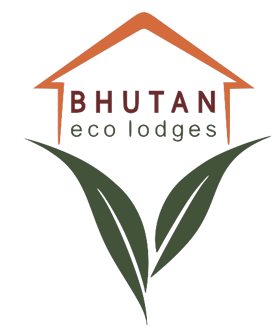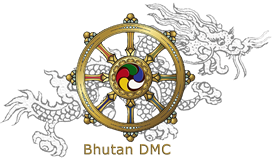Bhutan Spiritual Journey
Day 01 : Arrive Paro by Druk Air & transfer to Thimphu (55km, approx 1.1/2 hour drive)
The flight to Paro on a clear day is one of the most spectacular of all mountain flights. Whether flying along the Himalayan range from Kathmandu or over the foothills from Kolkatta, the journey offers fascinating views and an exciting descent into the Kingdom.
The first gift from Bhutan will be cool, clean fresh air as you step out of the aircraft. On arrival at Paro airport, you will be received by our representative with a “tashi khaddar” (white scarf offering to the guest which is an auspicious way to welcome guest) and transfer to Thimphu, the modern capital town of Bhutan.
Evening welcome dinner with local family. An eventful evening is spent with a local Bhutanese family who welcome the guests with hearty smile.
A welcome ritual and refreshment is followed by a short lecture by a professional Buddhist speaker.
Here guests can also try learning wearing the National dress of Bhutan which is one of the most distinctive and visible aspects of Dragon Kingdom's unique character. Men wear Gho, a long robe while women wear, ankle length robe called Kira. The Bhutanese textile is made from fine, hand-woven fabric, with the colorful distinctive patterns.
Dress wearing session is followed by sumptuous local Bhutanese dinner in ‘the real Bhutanese way’. Bhutanese cuisine uses significant amounts of Red Rice - one of the few varieties that grow at high altitude, along with buckwheat and maize. Mountain people's diet includes poultry, yak meat, dried beef, pork, pork fat and mutton.Soups and stews are very popular, and incorporate meats, rice, ferns, lentils.
Overnight at the hotel in Thimphu.
Day 02 : Thimphu
Early morning take a short drive (15 km) to Pangri Zampa, 16th century one of the oldest monasteries in Bhutan located just north of Thimphu. Here is a monastic school where Buddhist students monks learn Lamaism and astrology based on Buddhist philosophy. Guests can interact with monks.
Here a special prayer ceremony or Puja ceremony is organized.
This is a special prayer ceremony held at monastery by a team of monks for the peace, prosperity and good health, guests are required to lit butter lamp at monastery alter.
Lunch followed by a cultural tour of Thimphu
Continue on to National Library, which holds a vast collection of ancient Buddhist texts and manuscripts, some dating back several hundred years, as well as modern academic books mainly on Himalayan culture and religion.
.jpg) Also visit nearby Institute for Zorig Chusum: Commonly known as Arts & Crafts School or Painting School, the Institute offers a six-year course on the 13 traditional arts and crafts of Bhutan. On a visit, one can see students learning the various skills taught at the school.
Also visit nearby Institute for Zorig Chusum: Commonly known as Arts & Crafts School or Painting School, the Institute offers a six-year course on the 13 traditional arts and crafts of Bhutan. On a visit, one can see students learning the various skills taught at the school.
Followed by a visit to Simply Bhutan - an exclusive project under the Bhutan Youth Development Fund . It is a living Museum and Studio encapsulating the cultural heritage of the Bhutanese people. The infrastructure portrays ancient Bhutanese architecture which is being lost to modernization.
Evening visit Trashichhoedzong: This impressive fortress/monastery houses Secretariat building, the throne room of His Majesty, the King and various government offices. It is also the summer residence of Chief Abbot and central monk body.
Overnight at the hotel in Thimphu.
Day 03 : Thimphu – Gangtey ( Phobjikha ) (150km, approx 5 hours drive )
Morning after breakfast visit National Memorial Chorten: a monument for world peace and prosperity. The paintings and statues inside the monument provide a deep insight into Buddhist philosophy.
Then drive to Gangtey across Dochula pass (3,O8Om). In Bhutan, the passes are marked by a large Bhutanese Chorten and prayer flag. Dochula pass offers the most spectacular view over the high peaks of the eastern Himalayas on a clear day. You can stop here briefly to take in the view and admire the chorten, mani wall, and prayer flags which decorate the highest point on the road.
From Dochu-la pass, it is a long, winding descent into the Wangduephodrang valley, which is about 1,700m below the pass. Then drive on to Gangtey / Phobjikha. In the mountains east of Wangduephodrang lies the beautiful Phobjikha valley, on the slopes of which is situated the great monastery of Gangtey, established in the 17th century. The village of Phobjikha lies a few km, down from the monastery, on the valley floor. This quite, remote valley is the winter home of black necked cranes, which migrate from the arid plains of Tibet in the north, to pass the winter months in a milder climate.
The valley of Gangtey is one of the most beautiful spots in Bhutan. The surprise of finding such a wide, flat valley without any trees after the hard climb through dense forests is augmented by an impression of vast space, an extremely rare experience in Bhutan where most of the valley’s are tightly enclosed.
Visit the Gangtey Gompa : Perched on a small hill that rises from the valley floor, the Gangtey Monastery is the only Nyingmapa monastery on the western side of the Black Mountain’s and also the biggest Nyingmapa monastery in Bhutan. The Monastery is surrounded by a large village inhabited mainly by the families of the 140 Gomchens who take care of the Monastery.
Evening interaction with local monks, followed by dinner.
Overnight at the hotel in Gangtey.
Day 04 : Gangtey / Trongsa / Bumthang (153km, approx 7 hours drive)
Morning after breakfast drive to Bumthang via Trongsa across Pele-la pass (3,300m/10,830 ft), the traditional boundary between east and west. The pass is marked by a large white chorten prayer flags. There is an abrupt change in vegetation at this point, with mountain forest replaced by high altitude dwarf bamboo.
Stop en route at Chendbji Chorten, patterned on Kathmandu’s Swayambhunath Stupa, with eyes panted at four cardinal points. It was built in the 18th century by Lama Shida from Tibet, to cover the remains of an evil spirit that was subdued at this spot.
Arrive at Trongsa and visit the Trongsa Dzong. Built in 1648 it was the seat of power over central and eastern Bhutan. Both the first and second Kings of Bhutan ruled the country from this ancient seat. All four Kings were invested as Trongsa Penlop (‘governer’) prior to ascending the throne, and the present Crown Prince now holds the post. The Dzong is a massive structure with many levels, sloping down the contours of the ridge on which it is built.
After lunch in Trongsa drive to Bumthang, 68 km from Trongsa, a journey of about 3 hours, over the Yutong-la pass (3,400m/ 11,155 ft). The road winds steeply up to the pass, 28 km from Trongsa, then runs down through coniferous forest into a wide, open cultivated valley known as the Chumey valley.
On arrival in Bumthang, check in at your lodge. Evening at leisure.
Overnight at the Hotel in Bumthang.
Day 05 : Bumthang
After breakfast meditation session at Lhodrak Kharchhu monastery. Located above the main town, about 3 km from Chamkhar town, the monastery was founded by Namkhai Nyingpo Rinpoche in 1984 who was recognized at a very young age by H.H. the 14th Dalai Lama and H.H. 16th Karmapa as the reincarnation of a Tibetan lama whose spiritual lineage dates back to the nearest disciples of the great 9th century master. Since then the monastery has developed considerably with increase in number of monks to almost four hundred. The monastey has become part of an extensive effort to preserve and revitalize Tibetan culture. The monks regular curriculum include reading, memorizing the daily prayers, learning dharma dances, drawing mandalas, learning the melodies of sacred rituals, learning the use of ceremonial instruments and the art of making sacrificial objects, grammer, poerty, karika along with the basics of contemplation and instruction on the different stages of tantra.
Afternoon visit Kurje Lhakhang, where the saint Padmasambhava subdued a local demon and left his body imprint on a rock, the Jambey Lhakhang (7th century temple), Tamshing Lhakhang (housing some of the oldest wall paintings in Bhutan) and Jakar Dzong (administrative center of the region).
Overnight at the hotel in Bumthang.
Day 06 : Bumthang
After breakfast meditation session at Thangbi Goemba. A walk of half an hour north of Kurje Lhahang leads to this monastery, founded in 1470 by Shamar Rinpoche of the Kagyupa religious school. The temple has two sanctuaries and a temple of terrifying deities. The sanctuary on the ground floor contains statues of past, present and future Buddha and three clay statues probably dating end of the 15th century. On the upper floor, the vestibule contains two remarkable paintings of Guru Rinpoche's heaven and the Buddha Amitabh's heaven.
Later drive to Membartsho (The Burning Lake). Located in Tang valley, it is a wide spot on the Tang Chhu (chhu - water / river) and is considered to be one of the greatest pilgrimage sites of Bhutan. Pema Linga found several of Guru Rinpoche's hidden treasures here. The importance of this site is indicated by the extensive array of prayer flags and the small clay offerings called 'Tse Tsa' in rock niches.
Afternoon visit to :
Konchogsum Lhakhang: This temple was was built in the 6th century but was renovated in 1995, which accounts for its fresh look. It contained a large bell and it is said that when this bell was rung it could be heard all the way in Lhasa in Tibet. During the 17th century a Tibetan Army tried to steal this bell but was too heavy and they dropped it and cracked it. It is now displayed at the National Museum in Paro.
Chankhar Lhakhang : Beyond Jambay Lhakhang is Changkhar Lhakhang, the site of the palace of the Indian King Sindhu Raja. Because of its simplicity it looks like an ordinary village house. The original palace was built of iron and this is why it was named Chankhar, meaning iron castle. It was rebuilt in the 14th century by a Saint called- Dorji Lingpa.
Later interactive session with monks.
Overnight at the hotel in Bumthang.
Day 07 : Bumthang / Punakha (215km, approx 8 hours drive)
After breakfast at hotel, drive to Punakha across Yutong-la pass (3,400m/ 11,155 ft) & Pelela pass (3,300 m). Mountain passes offer the most spectacular view over the high peaks of the eastern Himalayas on a clear day.
En route stop at Ta Dzong, recently opened fort in Trongsa. The Ta Dzong, a cylindrical stone structure rising five stories, was built in 1652 by Chogyal Minjur Tempa, After more than 350 years, it has been resurrected into a classy museum, that represents a tasteful blend of tradition and modernity.
Evening can be spent exploring Punakha village located right on the bank of river.
Overnight at the hotel in Punakha.
Day 08 : Punakha / Paro (125km, approx 4 hours drive)
After breakfast proceed to visit Punakha Dzong, built strategically at the junction of Pho Chhu and Mo Chhu rivers in 1637, by Shabdrung Ngawang Namgyal to serve as the religious and administrative centre of the region, Punakha Dzong has played an important role in Bhutan's history.
Drive back to Paro descending back down from Dochu La, follow the way back up the dramatic Wang Chhu and Paro Chhu river valleys, before crossing through Paro Town towards the north end of the valley. Visit en route, Simtokha Dzong, the oldest fortress of the country which now houses the School for Buddhist studies.
On arrival check into hotel and later proceed for a short tour:
The beautiful valley of Paro encapsulates within itself a rich culture, scenic beauty and hundreds of myths and legends. It is home to many of Bhutan's oldest temples and monasteries, National Museum and country's only airport. Mount. Chomolhari (7,314m) reigns in white glory at the northern end of the valley and its glacial water plunge through deep gorges to form Pa Chhu (Paro river). Paro is also one of the most fertile valley in the Kingdom producing a bulk of the locally famous red rice from its terraced fields.
Visit Ta Dzong, originally built as Watchtower, which now houses National Museum. The extensive collection includes antique thangkha paintings, textiles, weapons & armour, household objects and a rich assortment of natural and historic artifacts.
Ta Dzong visit immediately followed by short walk down the trail to visit Rinpung Dzong, meaning (“fortress of the heap of jewels”), which has a long and fascinating history. Along the wooden galleries lining the inner courtyard are fine wall paintings illustrating Buddhist lore such as four friends, the old man of long life, the wheel of life, scenes from the life of Milarepa, Mount. Sumeru and other cosmic Mandala.
Overnight at the hotel in Paro.
Day 09 : Paro
After breakfast, take a short drive to Satsam Chorten (trail head point) for a walking excursion to Tiger’s nest (Taktsang Monastery). This most famous of Bhutan’s monasteries is perched on the side of a cliff 900m above the Paro valley floor. It is said that Guru Rinpoche arrived here on the back of a tigress, and meditated at this place, hence the monastery is also called ‘Tiger’s Nest’. This site, which has long been recognized as a most sacred place, was visited by Shabdrung Ngawang Namgyal in 1646, the religious and temporal ruler of Bhutan. It is a place of pilgrimage which Bhutanese try to visit at least once in a lifetime. In April, 1998 a fire severely damaged the main structure of the building but now it has been fully restored to its original grandeur. The excursion up to the cafeteria which is situated on a rocky outcrop across a ravine from the monastery, takes about five hours round trip.
Meditation session inside a campsite nearby monastery.
Evening return to the hotel for overnight stay.
Day 10 : Paro
Morning visit Kyichu Lhakhang. It is one of the oldest and most sacred shrines of the Kingdom dating back to 7th century (the other is Jambey Lhakahng in Bumthang). The lhakhang complex is composed of two temples. The first temple was built by Tibetan King, Songtsen Gampo in the 7th century and in 1968, H.M. Ashi Kesang, the Queen Mother of Bhutan, built the second temple in original pattern.
Later excursion to Kila Goemba. It is the serene home of Buddhist nuns who have dedicated their life for spiritual fulfillment and leading undisturbed life of religious studies, prayer and meditation. The goemba is nestled in a craggy patch on mountain side below the Chelela pass and perched precariously along the rock face. From Chelela pass, the lhakhang is about an hour walk amidst magnificent wooded area.
Evening visit a traditional farm house followed meditation session at same place.
Overnight at the hotel in Paro.
Day 11 : Depart Paro
After breakfast transfer to the airport for flight to onward destination.
HOTELS IN THIMPHU
HOTELS IN PUNAKHA & WANGDUE
HOTELS IN GANGTEY
HOTELS IN TRONGSA
HOTELS IN BUMTHANG
HOTELS IN MONGAR
HOTELS IN TRASHIGANG
HOTELS IN SAMDRUP JONGKHAR
HOTELS IN PHUENTSHOLING
HOTELS IN HAA
HOTELS IN GELEPHU
HOTELS IN ZHEMGANG
RESTAURANTS IN PARO
RESTAURANTS IN THIMPHU
RESTAURANTS IN PUNAKHA
TOUR ITINERARIES
TREKKING ITINERARIES
SPECIAL INTERESTS TOURS
UNIQUE FESTIVALS & FAIRS
BLOG


